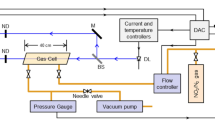Abstract
A method of standoff detection based on the observation of laser-induced fluorescence–amplified spontaneous emission (LIF-ASE) is described. LIF-ASE generates uniaxial intensity distributions of the observed fluorescence with the majority of intensity propagating along the excitation axis in both the forward and backward directions. The detection of bulk vapor at significant standoff distances is readily achieved. This method was used to detect NO directly and as a photoproduct after 213-nm excitation of 2-, 3-, and 4-nitrotoluene. The NO LIF-ASE spectra were studied as a function of buffer gas. These studies showed that the emission from different vibrational states was dependent upon the buffer gas used, suggesting that the populations of vibrational states were influenced by the environment. A similar sensitivity of the vibrational populations was observed when the different nitroaromatic precursors were used in nitrogen buffer gas. Such sensitivity to environmental influences can be used to distinguish among the different nitroaromatic precursors and facilitate the identification of the bulk vapor of these analytes.




Similar content being viewed by others
References
Woodfin RL (2007) Trace chemical sensing of explosives. Wiley, Hoboken, NJ, p 363
Moore DS (2007) Sensing and Imaging 8:9–38
Yinon J (2007) Counterterrorist detection techniques of explosives. Elsevier, London
Sharma SK, Misra AK, Lucey PG, Angel SM, McKay CP (2006) Appl Spectrosc 60:871–876
Carter JC, Angel SM, Lawrence-Snyder M, Scaffidi J, Whipple RE, Reynolds JG (2005) Appl Spectrosc 59:769–775
Janni J, Gilbert BD, Field RW, Steinfeld JI (1997) Spectrochimica Acta Part A-Molecular and Biomolecular Spectroscopy 53:1375–1381
Riris H, Carlisle CB, McMillen DF, Cooper DE (1996) Appl Opt 35:4694–4704
Todd MW, Provencal RA, Owano TG, Paldus BA, Kachanov A, Vodopyanov KL, Hunter M, Coy SL, Steinfeld JI, Arnold JT (2002) Appl Phys B-Lasers Opt 75:367–376
Ramos C, Dagdigian PJ (2007) Appl Opt 46:620–627
Portnov A, Rosenwaks S, Bar I (2008) Appl Phys Lett 93:041115
Shen YC, Lo T, Taday PF, Cole BE, Tribe WR, Kemp MC (2005) Appl Phys Lett 86:241116
Lo T, Gregory IS, Baker C, Taday PF, Tribe WR, Kemp MC (2006) Vibr Spectrosc 42:243–248
Shu J, Bar I, Rosenwaks S (2000) Appl Phys B 71:665–672
Daugey N, Shu J, Bar I, Rosenwaks S (1999) Appl Spectrosc 53:57–64
Wu DD, Singh JP, Yueh FY, Monts DL (1996) Appl Opt 35:3998–4003
De Lucia FC, Harmon RS, McNesby KL, Winkel RJ, Miziolek AW (2003) Appl Opt 42:6148–6152
Gronlund R, Lundqvist MSS (2006) Applied Spectroscopy 60853-859
Alden M, Westblom U, Goldsmith JEM (1989) Opt Lett 14:305–307
Huang YL, Gordon RJ (1992) J Chem Phys 97:6363–6368
Tserepi AD, Wurzberg E, Miller TA (1997) Chem Phys Lett 265:297–302
Summerlin LR, Borgford CL, Ealy JB (eds) (1988) Chemical demonstrations: a sourcebook for teachers, 2nd edn. American Chemical Society, Washington, DC
Luque J, Crosley DR (2000) J Phys Chem A 104:2567–2572
Kosmidis C, Marshall A, Clark A, Deas RM, Ledingham KWD, Singhal RP (1994) Rapid Commun Mass Spectrom 8:607–614
Arusi-Parpar T, Heflinger D, Lavi R (2001) Appl Opt 40:6677–6681
Boudreaux GM, Miller TS, Kunefke AJ, Singh JP, Yueh FY, Monts DL (1999) Appl Opt 38:1411–1417
Swayambunathan V, Sausa RC, Singh G (2000) Appl Spectrosc 54:651–658
Luque J, Crosley DR (1999) J Chem Phys 111:7405–7415
Lin MF, Lee YT, Ni CK, Xu SC, Lin MC (2007) J Chem Phys 126:064310
SenGupta S, Upadhyaya HP, Kumar A, Dhanya S, Naik PD, Bajaj P (2008) Chem Phys Lett 452:239–244
Sheaff CN, Eastwood D, Wai CM, Addleman RS (2008) Appl Spectrosc 62:739–746
Acknowledgments
This work was supported in part by the U.S. Army Research Office.
Author information
Authors and Affiliations
Corresponding authors
Rights and permissions
About this article
Cite this article
Arnold, B., Kelly, L., Oleske, J.B. et al. Standoff detection of nitrotoluenes using 213-nm amplified spontaneous emission from nitric oxide. Anal Bioanal Chem 395, 349–355 (2009). https://doi.org/10.1007/s00216-009-2990-7
Received:
Revised:
Accepted:
Published:
Issue Date:
DOI: https://doi.org/10.1007/s00216-009-2990-7




